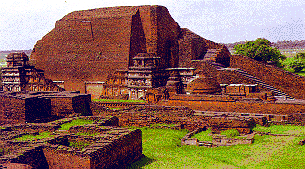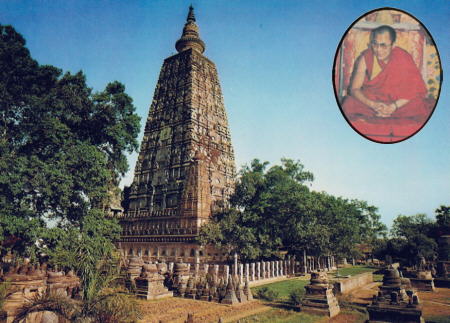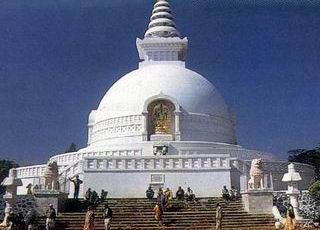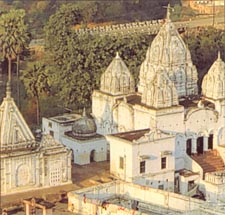|
Of
all India's states, Bihar is the one most intimately linked to
the Buddha's life, resulting in a trail of pilgrimages, which
have come to be known as the Buddhist circuit. It derived its
name from the word 'vihara', which means Buddhist monastery.
The
Buddhist trail begins at the capital city, Patna, where a
noteworthy museum contains a collection of Hindu and Buddhist
sculptures. The Khuda Baksh Oriental Library has rare Muslim
manuscripts including some from the University of Cordoba in
Spain. 40 km away, Vaishali was the site for the second
Buddhist Council as the presence of ruins testifies.
90
km south of Patna is Nalanda, which translates as 'the place
that confers the lotus' (of spiritual knowledge). A monastic
university flourished here from the 5th to the 11th century.
It is said to have contained nine million books, with 2,000
teachers to impart knowledge to 10,000 students who came from
all over the Buddhist world.
Rajgir,
'the royal palace', 12 km south, was the venue for the first
Buddhist Council. The Buddha spent five years at Rajgir after
having attained enlightenment, and many of the remains at
Rajgir commemorate various incidents, the hill of Gridhrakuta
being perhaps the most important, as this is where the Buddha
delivered most of his sermons. Bodhgaya is the spot where Lord
Buddha attained enlightenment, with the Mahabodhi Temple
marking the precise location.
General
information
|
Population
|
82,
878, 796
|
|
Area
|
94,164
sq km
|
|
Capital
|
Patna
|
|
Languages
Spoken
|
Hindi
|
|
District
|
37
|
|
People
Per Sq. km
|
880
|
|
Literacy
|
47.53%
|
Fairs and Festivals
Chatt Puja
Chatt
Puja is the only occasion where the setting sun is worshipped.
The people of Bihar have immense faith in this festival. It is
celebrated twice a year, once in ‘Chaitra’ (according
to the Hindu calendar), which falls in March and in ‘Kartik
‘, which falls in November. For this 4-day festival, people
maintain sanctity and purity from even a month ahead. People
celebrate this festival with immense faith the folk songs sung
in the honour of ‘Surya Dev’ and ‘Chatti Maiyya’ can
be heard at every nook and corner the sweetness of the songs
lets you feel the holiness of the festival.
Women fast for the good of their family and the society.
Regardless of the social status, to celebrate this festival
only the faith counts. Though it is a festival of the Hindus,
some of the Muslims also participate actively in the puja.
Sama-Chakeva
It
is during the winter season that the birds from the Himalayas
migrate towards the plains. With the advent of these colorful
birds, celebration of sama–chakeva is done. This is a
festival especially celebrated in mithila. Mithilanchal
dedicates this festival to the celebration of the brother
sister relationship. It represents the tradition of this land
as well as the art of making idols. This festival starts with
the welcoming of the pair of birds sama-chakeva. Girls make
clay idols of various birds and decorate them in their own
traditional ways. Various rituals are performed and the
festival joyfully ended with the ‘vidai’ of sama and with
a wish that these birds return to this land the next year.
Ramnavami
A
Hindu festival celebrated in all parts of the country. This is
the auspicious day when lord RAMA was born. People celebrate
it observing fasts and offering prayers in his honor.
Makar-Sankranti
Also
known as Tila Sankranti, the festival marks the beginning of
the summer season. People believe that from this day on, the
days become longer and the heat of the sun also increases.
Every year it is observed on the 14th of January. People
celebrate it by giving offerings to the poor.
Bihula
Bihula
is a prominent festival of eastern Bihar especially
famous in Bhagalpur district. There are many myths
related to this festival. People pray to goddess ‘Mansa’
for the welfare of their family.
Art
and Handicraft
Tikuli
Art
This
art originated from the gold foiled Tikuli, bindis with a
glass base, adoring the forehead of the Queens and Aristocrats
ladies of yore. Today hard board, enamel paints and Madhubani
motils are used to create produce for interior decorations and
utility items like tablemats and coaster. These art pieces are
heat proof and waterproof.
Mithila
Arts
Bihar
boasts of an enviable wealth of rural handicrafts comprising
of hand - painted wall hangings, wooden stools, miniatures in
paper and leaves, stone pottery, bamboo and leather goods, and
appliqué work. But Bihar’s most famous and fascinating
indigenous art forms, by far, are its Madhubani Paintings.
This art is a strict monopoly of the women of Mithila. Done in
primary colors of natural origin on paper and cloth, they
narrate mythological and religious events.
The art of Mithila is linked to religious ceremonies,
particularly marriage and its consequence, procreation.
Interspersed with the Vedic marital rites, with the Sanskrit
chanting by the Brahmins, is a tradition controlled by the
women and devoted to female deities Durga, Kali and Gauri.
Wall
Paintings
The
wall paintings have deeper themes, also narratives, for they
are the stories being told sometimes in a series of panels.
Apart from their decorative purpose, they also constitute a
form of visual education like picture books, from which ones
learns of ones heritage. Some outstanding ones are done in the
Madhubani area. They have a naiveté and simplicity, which
perhaps is their attraction that both soothes and pleases the
eyes. Wall Painting is communal act done by all the women of a
family or group.
Sujuni
The
first mention of a crafts similar to ‘’ Sujuni’’ comes
in the description of bedspreads and wall hanging of Uzbek;
they were popular as ‘SUJUNI’ (from Persian and Tadjik
ward for needle). Sujuni is a labor intensive but simple
embroidery. Tiny running stitches cover the entire fabric,
which is traditionally white or red, with the main outlines of
the motive highlighted in a thick chainstitch.
Bamboo
Work
Bihar
greatly noted for its bamboo work sends itself to multifarious
uses. The use of cut bamboo as a container to drink water is
an ancient practice. In fact the rural people in remote, still
keep their precious possessions in bamboo basket with side.
Against this tradition, commendable experiments work has been
done in Patna to adopt these very object to modern use. Finely
shaped lamps and lanterns, elegant furniture, complete
tableware, travel kit, almost anything seems possible to get
from the bamboo.
Wood
Inlay
Wood
inlay is one of Bihar’s ancient industries. The inlay
continues to be done with different materials, metal, ivory
and, stage horn chips of woods in other grains or tints are
used to get varied effects to great advantage. Apart from
decorative pieces like wall hanging, tabletops, trays, a
number of utility articles are also ornamented with inlay
work. The designs are mostly geometrical but very fine and
colorful.
Tapper
Mats
Tapper
mats are made on a large scale in Palamau district, Bihar.
Tapper is rather like jute, taken out of the sun hemp plant.
The usual method of soaking and using pressure is used to
extract the fiber, which is then spun into yarn and used for
making tapper. This is said do be more durable than jute
fiber. The yarn is dyed generally in indigenous colors, which
used to transport grain on any heavy stuff. Today a number of
article, of modern use are made like travel kit and hand bags,
some of them quite, stylish looking. Hazaribagh and Purnea
also produce tapper
|









